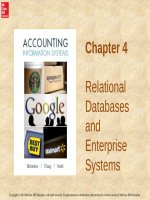Lecture Accounting information systems: Chapter 9 - Richardson, Chang, Smith
Bạn đang xem bản rút gọn của tài liệu. Xem và tải ngay bản đầy đủ của tài liệu tại đây (644.63 KB, 20 trang )
Chapter 9
Reporting
Processes and
eXtensible
Business
Reporting
Language
(XBRL)
Copyright © 2014 McGrawHill Education. All rights reserved. No reproduction or distribution without the prior written consent of McGrawHill Education.
Learning Objectives
•
•
•
•
LO#1 Explain how data warehouses are created and
used
LO#2 Describe the basic components of business
intelligence and how they are utilized in a firm
LO#3 Describe how digital dashboards allow for
continuous tracking of key metrics
LO#4 Explain how XBRL works and how it makes
business reporting more efficient
6-2
Data Warehouses
•
•
LO# 1
A data warehouse is a collection of
information gathered from an assortment
of external and operational (i.e, internal)
databases to facilitate reporting for
decision making and business analysis.
Data warehouses often serve as the main
repository of the firm's historical data, or in
other words, its corporate memory and
will often serve as an archive of past firm
performance.
9-3
Data Warehouses
•
Data warehouses are kept separate from the operational database.
–
•
Information in the warehouse can be stored safely for extended
periods of time and data warehouses can run data queries
without slowing down the performance of the company’s
operational systems.
Data warehouses do work together with operational systems to
provide necessary insight, particularly in the case of customer
relationship management (CRM) and supply chain management
(SCM) systems.
–
•
LO# 1
What are customers buying? What did they buy in a recession? What did they
buy after a natural disasters? What do they buy as their income goes up?
Data warehouses are often designed to facilitate decision making
such as those often used in managerial accounting.
–
9-4 variance
Output might include variance reports, trend reports,
Model of Data Warehouse
Design
9-5
LO# 1
Business Intelligence
•
•
Business Intelligence is a computerbased technique for accumulating and
analyzing data from databases and data
warehouses to support managerial
decision making.
One way that firms may gather business
intelligence is by use of a web crawler,
which systematically browses the World
Wide Web in a systematic way, collecting
information.
9-6
LO# 2
Process of Business
Intelligence
•
•
•
LO# 2
Gather information (either internal
information, external information or both)
from a variety of sources.
Analyze the data to discern patterns and
trends from that information to gain
understanding and meaning.
Make decisions, hopefully better informed
ones, based on the information gained.
9-7
Examples of Business
Intelligence
•
•
LO# 2
How would American Airlines (hub in
Dallas) and US Airways (hub in Phoenix)
use business intelligence to track its
competitor’s prices over different times,
days of the week, etc.?
How would Merrill Lynch use business
intelligence to price an initial public
offering of stock for a firm in the Internet
retail industry?
–
9-8
They may use business intelligence
to assess
LO# 2
Data Mining
•
Data mining is one technique used to
analyze data for business intelligence
purposes. Data mining is a process using
sophisticated statistical techniques to
extract and analyze data from large
databases to discern patterns and trends
that were not previously known.
–
Data mining is often used to find patterns in
stock prices to assist technical financial stock
market analysts, or in commodities or
9-9
Data Mining
•
LO# 2
Data mining will only find statistical
relationships and some of them represent
spurious correlations. Data mining must
be coupled with common sense to
interpret the statistical relationships found.
–
There is a classic example that ice cream
sales are correlated with drownings
suggesting that as ice cream sales increase,
the number of drownings also increase. That
does not mean that ice cream sales cause
drownings or that drownings cause9-10
more ice
Digital Dashboards
•
LO# 3
A digital dashboard is designed to track
the firm process or performance indicators
or metrics to monitor critical performance.
–
Orders month to date, days that receivables
are outstanding, budget variances, and days
without an accident on the assembly line, etc.
are all examples of what might be tracked
continuously.
9-11
Example of Digital Dashboard at GE
9-12
LO# 3
LO# 4
Financial Reporting and XBRL
•
•
XBRL stands for eXtensible Business
Reporting Language and is based on the
XML language, a standard for Internet
communication between businesses.
The XBRL database is available for
various uses, including reporting on the
firm’s web site, filing to regulators (SEC,
IRS, etc.) and providing information to
other interested parties such as financial
analysts, loan officers and investors.
9-13
LO# 4
Financial Reporting Using XBRL
9-14
XBRL Terminology
•
•
•
The XBRL taxonomy defines and
describes each key data element (e.g.,
total assets, accounts, payable, net
income, etc.).
XBRL instance documents contain the
actual dollar amounts or the details of
each of the elements within the firm’s
XBRL database.
XBRL style sheets take the instance
documents and add presentation9-15
LO# 4
LO# 4
Should XBRL be audited?
What assurances do we need on
We believe XBRL
Assurance should
XBRL?
•
include the following assurances that:
–
The most current, standardized XBRL
taxonomy is used,
–
The underlying financial and nonfinancial data
that is used in XBRL tagging is reliable,
–
The XBRL tagging is accurate and complete,
and,
–
The reports generated using XBRL are
complete and received on a timely9-16
basis.
LO# 4
XBRL GL
•
•
XBRL GL is also known as XBRL Global
Ledger Taxonomy
XBRL GL allows the representation of
anything that is found in a chart of
accounts, journal entries or historical
transactions, financial and non-financial.
9-17
How XBRL Works
9-18
LO# 4
LO# 4
XBRL Summary
•
•
XBRL serves as a means to electronically
communicate business information to
facilitate business reporting of financial
and nonfinancial data to users.
XBRL greatly enhances the speed and
accuracy of business reporting.
9-19
Summary
•
Data warehouses serve as a repository of
information that is separate from the
operating databases of the firm to support
decision making across a number of
functions in the firm.
–
•
LO# 4
Data marts represent a slice of data from the
data warehouse to meet a specific need.
Business intelligence uses computerbased techniques to accumulate and
9-20to the
analyze data that might be helpful









